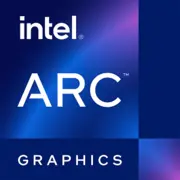Intel Arc Pro A50

Intel Arc Pro A50: Detailed Review of the Graphics Card for Gamers and Professionals
April 2025
1. Architecture and Key Features
Xe-HPG 2.0 Architecture: Intel's Evolution
The Intel Arc Pro A50 graphics card is built on the updated Xe-HPG 2.0 architecture, which is a logical evolution from the first version. Major improvements focus on optimizing ray tracing performance and increasing energy efficiency. The manufacturing technology is TSMC N6 (6 nm), which has helped reduce thermal output and increase clock frequencies.
Unique Features
- XeSS 2.0 — This is Intel’s answer to NVIDIA's DLSS, but it is open source. Machine learning algorithms enhance image resolution with minimal quality loss. In games like Cyberpunk 2077, XeSS 2.0 provides a performance boost of 30–40% in Quality mode (1440p).
- Hardware Ray Tracing — Eight accelerated RT cores deliver realistic lighting. It performs decently in Metro Exodus Enhanced Edition (45–50 FPS on medium settings at 1080p).
- Support for FidelityFX Super Resolution (FSR) — Compatibility with AMD's technology broadens the list of optimized games.
2. Memory: Speed and Efficiency
GDDR6 and Bandwidth
The Arc Pro A50 features 8 GB of GDDR6 with a 128-bit bus. The memory bandwidth reaches 384 GB/s, which is 15% higher than that of the previous generation (A40). This is sufficient for gaming at 1080p and 1440p, but there may be limitations at 4K due to the memory capacity.
Impact on Performance
- In Call of Duty: Modern Warfare V (1440p, Ultra), the graphics card delivers stable 75–80 FPS.
- When ray tracing is activated in Control (1080p, High), FPS drops to 40–45, but with XeSS 2.0, it rises to 60.
3. Gaming Performance
Resolutions and Settings
- 1080p: An ideal choice for esports projects. In Apex Legends (Ultra) — 120–130 FPS.
- 1440p: Comfortable gaming in AAA titles. Horizon Forbidden West — 55–60 FPS (High).
- 4K: Only for less demanding games or with XeSS/FSR enabled. Fortnite (Epic) — 40–45 FPS.
Ray Tracing: Is It Worth It?
RTX load “eats up” to 30% of performance. It is recommended to enable RT only in combination with XeSS/FSR. For example, in Cyberpunk 2077 (1080p, RT Medium + XeSS Balanced) — 55–60 FPS.
4. Professional Tasks
Video Editing and Rendering
With support for AV1 and HEVC, the A50 is effective in DaVinci Resolve and Premiere Pro. Rendering a 10-minute 4K video takes about 8 minutes (comparable to NVIDIA RTX 3060).
3D Modeling
In Blender and Maya, the card shows average results. OpenCL performance is 20% lower than that of the RTX 3050, but it is sufficient for beginner designers.
Scientific Calculations
Support for oneAPI and OpenCL makes the A50 suitable for machine learning and simulations. However, the lack of a CUDA equivalent limits its use in specialized tasks.
5. Power Consumption and Thermal Output
TDP and Recommendations
The model has a TDP of 95 W, allowing it to run without additional power (powered via PCIe x16).
Cooling
- The standard cooling system is dual-fan, with noise levels up to 32 dB under load.
- For cases with poor ventilation, it is recommended to install additional intake fans.
6. Comparison with Competitors
NVIDIA RTX 3050 (8 GB)
- Pros of NVIDIA: Better ray tracing support (50–55 FPS in Control compared to 40–45 for A50) and driver stability.
- Cons: Higher price ($230 versus $200 for A50).
AMD Radeon RX 7600
- Pros of AMD: Higher performance in Vulkan games (e.g., Red Dead Redemption 2 — 70 FPS compared to 65 for A50).
- Cons: Lack of hardware AV1 encoder.
7. Practical Tips
Power Supply
A power supply of 450 W is sufficient (e.g., Corsair CX450). For systems with Core i5/i7 class processors, a 550 W unit is recommended.
Compatibility
- Motherboards: PCIe 4.0 x16 (backward compatible with PCIe 3.0).
- Recommended drivers: Intel continuously improves optimization — update the software through the Intel Driver & Support Assistant.
8. Pros and Cons
Pros
- Price of $200 for 8 GB of GDDR6.
- Support for AV1 and XeSS 2.0.
- Low power consumption.
Cons
- Limited ray tracing performance.
- Drivers still lag behind NVIDIA in stability.
9. Final Verdict: Who is the Arc Pro A50 For?
This graphics card is an excellent choice for:
- Gamers with a budget of up to $250, who want to play at 1440p.
- Content creators working with AV1 content.
- Users who value energy efficiency.
If you don’t need maximum ray tracing performance, but care about modern codecs and low price, the A50 will be a good purchase. However, for professional 3D rendering, it's better to consider the NVIDIA RTX 3060 or AMD Radeon Pro W6600.
Prices are current as of April 2025. The stated cost refers to new devices.
Basic
Memory Specifications
Theoretical Performance
Miscellaneous
Benchmarks
Compared to Other GPU
Share in social media
Or Link To Us
<a href="https://cputronic.com/en/gpu/intel-arc-pro-a50" target="_blank">Intel Arc Pro A50</a>